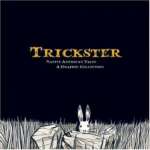
All cultures have tales of the trickster—a crafty creature or being who uses cunning to get food, steal precious possessions, or simply cause mischief. He disrupts the order of things, often humiliating others and sometimes himself. In Native American traditions, the trickster takes many forms, from coyote or rabbit to raccoon or raven. The first graphic anthology of Native American trickster tales, Trickster brings together Native American folklore and the world of comics.
Related: Folklore and Fairy Tales, Graphic Novel, Intermediate (ages 9-14), Short Stories - Anthologies - Collections, United States
- ISBN: 9781555917241
- Author: Dembicki, Matt
- Published: 2010, Fulcrum Publishing
- Themes: Indigenous, Tricksters
- Descriptors: Folklore and Fairy Tales, Graphic Novel, Intermediate (ages 9-14), Short Stories - Anthologies - Collections, United States
- No. of pages: 232

Ann
I enjoyed the approach of this book – Native American tales done in graphic style. When I first heard about it, I was worried that the artists themselves were interpreting the stories (or even creating them?) but I was pleasantly surprised to read in the back of the book that the graphic artists teamed up with well-known Native American storytellers to bring these stories to life. Graphic novels are quite popular these days, and these tales of tricksters – coyotes, rabbits, ravens, raccoons, people – seem to be perfect for this medium, since children might not be familiar with some of the characters. I also like the fact that each tale is drawn by a different artist, making you want to keep reading the next story to see how the artist interpreted it.
The one thing that surprised me was the fact that some of the stories ended with a moral. Traditionally, Native American stories don’t have a stated moral, but rather allow the listener (when they were shared orally) to draw his or her own conclusion about the behaviors the story condemned or condoned. However, these stories came directly from Native American storytellers, so perhaps this is a method they use when sharing their stories.
Celeste
One thing I find fascinating is the intersection of genre. Graphic narratives exude a sometimes edgy and young vitality. Pairing this visual style of storytelling with the ancient and grounded tradition of oral storytelling has created a book of complementary contradiction and hidden complexity. And I think it is this the tension that makes the book appealing.
I read an interview with Tim Tingle about his contribution to Trickster. In it, he mentions how happy he was to be a part of it, as he had seen the enthusiasm middle school students displayed regarding graphic narratives. Also, he noted the importance of humor in trickster tales, and I couldn’t help but think of the importance of humor for adolescents, as well. This is a book that fulfills so many roles at once.
My favorite chapters did not contain human characters. “How the Alligator got his Brown, Scaly Skin” and “Azban and the Crayfish” both held me visually interested as well as curious about the story. However, many of the illustrations of Native human beings made me uncomfortable. The main character in “Moshup’s Bridge” resembles He-man and other chiseled jaw strongmen of American comics. The people in “Waynaboozhoo and the Geese” as well as “The Yehasuri: The little wild Indians” and “When Coyote Decided to get Married” seemed like stereotypical feathered, buckskinned Natives. But it is difficult for me to criticize because the Native storytellers approved all of the artwork.
Ann
I like your idea of how the juxtaposition of modern-day graphics and timeless stories create something that is totally unique and fresh. I wonder how much the artists collaborated with the storytellers, since generally there is no collaboration in picture books between artist and illustrator. However, in a book with stories that are embedded in a culture, I would think there was at least some discussion between the artist and writer to ensure that the cultural perspective was upheld.